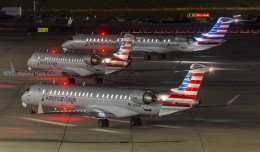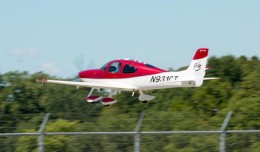Here’s another good example of laziness in the press’s coverage of airplane stories. In this case it’s an airport story from November 2012, courtesy of our old friends the Associated Press.

Koko Nicole Anderson, 21, from Mesa, Ariz., is shown after being jailed on aggravated DUI and criminal damage charges in this handout photo provided by the Maricopa County Sheriff’s Office on Friday, Nov. 16, 2012. Anderson was charged after crashing her car through a gate at Phoenix Sky Harbor International Airport Thursday night, driving on the runway in the latest in a series of similar mishaps across the country that have raised questions whether the nation’s airports are truly secure.
“(AP) A woman driving with her infant son in her car crashed through a gate at Phoenix Sky Harbor International Airport and drove on the runway in the latest in a series of similar mishaps across the country that have raised questions whether the nation’s airports are truly secure. The woman rammed the partially open airport gate around 10 p.m. Thursday and started crossing the runway, police spokesman Sgt. Trent Crump said. Such incidents are troublesome because a vehicle that crashed into a jetliner landing or taking off could cause a catastrophe, whether it was an intoxicated driver behind the wheel or a terrorist, said Jeff Price, an aviation professor at the Metropolitan State University of Denver.”
“The runway?” Really? May I ask which one? Phoenix Sky Harbor International Airport (PHX) has three runways.
Would it have been that troublesome to simply say, “one of the runways,” or “a runway”?
Though, to be honest, I’m skeptical that the woman drove her car onto a runway at all. I’m skeptical not only because no attempt was made to clarify which one, but because reporters have a bad habit of referring to pretty much any portion of airport tarmac as a “runway.” Taxiways, terminal ramps, etc., are commonly called “runways,” when in fact they are not. I should hardly have to point this out, but the runway is a very specific thing with a very specific purpose: it’s that long and clearly defined strip of pavement that planes take off from and land on.
The silliest part, though, is that line about the dangers of a collision between and airplane and a car. Could such a collision actually cause a catastrophe? Absolutely. But did the reporter really need to call up an aviation professor at some college in Colorado to confirm this? What a bizarre conversation that must have been.
(Actually, the silliest part is that the police sergeant’s name is Trent Crump, but that’s not the AP’s fault.)
I have a problem, in general, with the media’s reliance on aviation academics. It’s extremely common for reporters to cite aviation professors, aerospace researchers, and the like, in their stories. I understand the temptation here, and with certain topics these individuals can offer valuable insights. But what reporters don’t realize is that professors and researchers can be highly unfamiliar with the day-to-day operational aspects of commercial flying. This is not their expertise. If the topic is aerodynamics, meteorology, or something statistical, that’s one thing. But for anything that touches the nitty-gritty of airline operations and the SOPs of flying jetliners, professors are often terrible sources, with little idea what they’re talking about.
This business about runways, meanwhile, reminds us of another annoying habit of the news media: its custom, in pretty much any story about an accident or incident, of referring to “the pilot.”
Commercial jets are flown by a cockpit crew of at least two people: a captain and first officer. The latter is known colloquially as the “copilot”, but they are both pilots, and they are both fully qualified to operate the aircraft.
Citing “the captain” would be better — though bear in mind that the captain may or may not have been the person actually flying the aircraft at the moment of any accident or incident. First officers fly too, performing just as many takeoffs and landings as captains do. And often, during emergencies or other abnormal situations, the captain will handle the checklists and troubleshooting, while delegating the hands-on flying duties to the first officer.
Thus the safest and most accurate option would be to refer to “the crew,” or “the pilots,” plural.
Wait, we’re not finished yet…
We’ve also got the issue of emergency landings. Basically, any and every time a plane diverts or returns to its airport of origin, be it for a mechanical problem, medical issue, or anything else, the event is described as “an emergency landing.”
In fact, the vast majority of what are described as emergency landings are simple, precautionary diversions or returns. Actual emergency landings are rare, and pilots do not employ the term nearly as loosely as the media does. The captain must specifically declare an emergency to air traffic control. Situations vary, but generally it pertains to a situation in which expedited air traffic control handling is requested, and/or aircraft status is uncertain. Even then, most emergencies aren’t anything close to the life-or-death scenarios many passengers (or TV reporters) are prone to imagining.
Last but not least, I’m tired of being told about alleged terrorist schemes to blow up entire airports.

Ahmed Ressam is an Algerian al-Qaeda member (dubbed the Millennium Bomber) who lived for a time in Montreal, Canada. He received extensive terrorist training in Afghanistan.
In October 2012, the re-sentencing of would-be Millennium Bomber, Ahmed Ressam, was making the media rounds. Rassam, you might recall, was the fellow caught driving into the US from Canada in 1999 with a trunk full of explosives. He originally was given 22 years in prison, but in that October was re-sentenced to 37 years. His plan was to detonate the explosives at LAX. To bomb the airport, in other words. But in story after story after story, both then and now, we have been told that Ressam had intended to “blow up the Los Angeles airport.” If only I had a dollar for every time I’ve read and heard this childish phrase — in newspapers, on the Internet, and on radio and TV.
Rassam maybe have blown up a terminal — or a portion of one. He may have blown up part of the airport. Terrible things, yes. But he was not, under any circumstances, going to destroy the entire LAX complex, or anything remotely close to it.
We heard exactly the same thing in 2007, when three men (one of whom, curiously, had been a member of the Parliament of Guyana) were arrested and convicted in a conspiracy to blow up tanks of jet fuel at Kennedy Airport in New York. Or, as the new stories had it, and continue to have it, they were convicted in a plot to “blow up New York’s Kennedy Airport.” Google it, and start counting.
How exactly does one blow up a 5,000-acre complex — complete with 30 miles of road, nine miles of runway, nine terminals, and dozens of other buildings?
Answer: short of possessing a nuclear weapon, you don’t.
I know how this might sound. But these aren’t just petty or semantic complaints. I understand the need for clarity; I understand space constraints and the other editorial excuses. But the press has a duty and obligation to get it right, and it is in the attention to detail that a reader’s trust is ultimately won or lost. And what of extrapolation: If aviation it treated so shoddily, should we not expect the same in matters of law, science or economics?
And these are just the nitpick examples. Rarely is an aviation article free from some measure of distortion, exaggeration, or at times outright nonsense. On the one hand, journalists face a challenge. They are working on deadline, under the pressure of limited word counts, assigned to a topic about which they probably know very little. Aviation is a particularly strange and insular field, overflowing with jargon, stubborn mythology, and recalcitrant entities (airlines). It’s not an easy beat.
But the answers are out there. Accurate and reliable sources are available (I, for one, will happily pick up the phone, and I’m usually willing to speak on the record). If nothing else, can’t we get the easy stuff right? The issues above are almost comically obvious and simple to correct.
To be fair, there are reporters whose expertise and accuracy rises above the fray. To name names, I’ll give you Christine Negroni, who writes for the New York Times, Susan Carey at the Wall Street Journal, Nicola Clark at the International Herald Tribune, and Slobodan Lekic of the Associated Press, among others.
But these, unfortunately, are the exceptions to the rule. When it comes to airplanes and pilots, mainstream journalism, like Hollywood, usually gets it wrong. Movies we can forgive. The press, however, we hold to a much higher standard. Though sometimes I wonder who is trying harder.
This article was originally published on AskThePilot.com(http://www.askthepilot.com/airplanes-and-the-media/) and is used here with the author’s permission. Patrick Smith is an airline pilot, author, and host of AskThePilot.com. His new book is COCKPIT CONFIDENTIAL: Everything You Need to Know About Air Travel. He lives in Somerville, Massachusetts.IN







